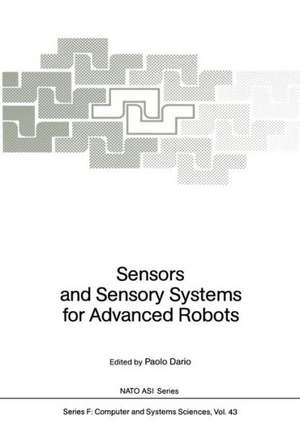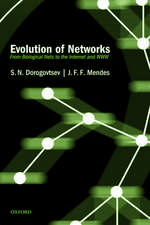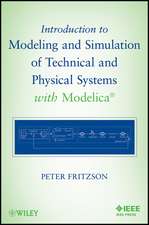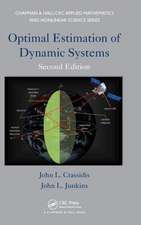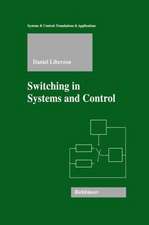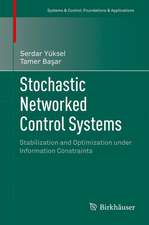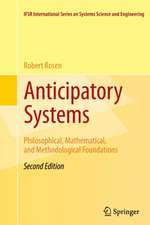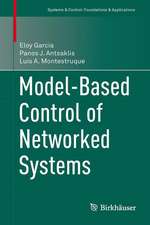Sensors and Sensory Systems for Advanced Robots: NATO ASI Subseries F:, cartea 43
Editat de Paolo Dario, Centro E. Piaggioen Limba Engleză Paperback – 7 sep 2012
Din seria NATO ASI Subseries F:
- 20%
 Preț: 650.27 lei
Preț: 650.27 lei - 20%
 Preț: 668.55 lei
Preț: 668.55 lei - 20%
 Preț: 992.44 lei
Preț: 992.44 lei - 18%
 Preț: 1239.19 lei
Preț: 1239.19 lei - 20%
 Preț: 1922.81 lei
Preț: 1922.81 lei - 20%
 Preț: 654.37 lei
Preț: 654.37 lei - 18%
 Preț: 1234.00 lei
Preț: 1234.00 lei - 20%
 Preț: 709.78 lei
Preț: 709.78 lei - 20%
 Preț: 656.03 lei
Preț: 656.03 lei - 18%
 Preț: 1854.94 lei
Preț: 1854.94 lei - 20%
 Preț: 374.97 lei
Preț: 374.97 lei - 20%
 Preț: 991.94 lei
Preț: 991.94 lei - 20%
 Preț: 671.02 lei
Preț: 671.02 lei - 20%
 Preț: 1925.96 lei
Preț: 1925.96 lei - 20%
 Preț: 994.73 lei
Preț: 994.73 lei -
 Preț: 389.49 lei
Preț: 389.49 lei - 20%
 Preț: 657.99 lei
Preț: 657.99 lei - 20%
 Preț: 655.20 lei
Preț: 655.20 lei - 18%
 Preț: 1225.31 lei
Preț: 1225.31 lei - 18%
 Preț: 952.09 lei
Preț: 952.09 lei - 20%
 Preț: 332.06 lei
Preț: 332.06 lei - 20%
 Preț: 1284.47 lei
Preț: 1284.47 lei - 20%
 Preț: 644.81 lei
Preț: 644.81 lei -
 Preț: 395.85 lei
Preț: 395.85 lei - 18%
 Preț: 1221.07 lei
Preț: 1221.07 lei - 15%
 Preț: 643.34 lei
Preț: 643.34 lei - 20%
 Preț: 645.47 lei
Preț: 645.47 lei - 20%
 Preț: 1282.98 lei
Preț: 1282.98 lei - 20%
 Preț: 656.36 lei
Preț: 656.36 lei - 20%
 Preț: 1283.31 lei
Preț: 1283.31 lei - 20%
 Preț: 1924.15 lei
Preț: 1924.15 lei - 20%
 Preț: 362.24 lei
Preț: 362.24 lei
Preț: 352.35 lei
Preț vechi: 440.43 lei
-20% Nou
Puncte Express: 529
Preț estimativ în valută:
67.43€ • 73.22$ • 56.64£
67.43€ • 73.22$ • 56.64£
Carte tipărită la comandă
Livrare economică 22 aprilie-06 mai
Preluare comenzi: 021 569.72.76
Specificații
ISBN-13: 9783642834127
ISBN-10: 3642834124
Pagini: 616
Ilustrații: XI, 600 p. 60 illus., 7 illus. in color.
Dimensiuni: 170 x 244 x 32 mm
Greutate: 0.97 kg
Ediția:Softcover reprint of the original 1st ed. 1988
Editura: Springer Berlin, Heidelberg
Colecția Springer
Seria NATO ASI Subseries F:
Locul publicării:Berlin, Heidelberg, Germany
ISBN-10: 3642834124
Pagini: 616
Ilustrații: XI, 600 p. 60 illus., 7 illus. in color.
Dimensiuni: 170 x 244 x 32 mm
Greutate: 0.97 kg
Ediția:Softcover reprint of the original 1st ed. 1988
Editura: Springer Berlin, Heidelberg
Colecția Springer
Seria NATO ASI Subseries F:
Locul publicării:Berlin, Heidelberg, Germany
Public țintă
ResearchCuprins
1. The Biological Model: the Human Body and its Sensory Systems.- The central nervous system as a low and high level control system.- Proprioceptive feedback for sensory-motor control.- Physiology and psychophysics in taste and smell.- The physiology and psychophysics of touch.- 2. The Artificial Counterpart: Robots and their Sensory Functions. General Memarks.- Steps toward making robots see.- An overview of local environment sensing in robotics applications.- Force and tactile sensing for robots.- 3. Physics of Transduction and Transducing Techniques.- Basic transduction mechanisms and techniques.- Analogs of biological tissues for mechanoelectrical transduction: Tactile sensors and muscle-like actuators.- Solid state transducers.- Fibre optic sensors in advanced robotic systems.- 4. Applications.- Models of errors and mistakes in machine perception: First results for computer vision range measurements.- Holographic techniques.- Electrical proximity sensors.- Ultrasonic sensors.- Acoustic imaging in three dimensions.- Gas sensors: Towards an artificial nose.- Development and application of humidity sensors.- Development and application of chemical sensors in liquids.- 5. Integration of Sensory Systems.- Integration of robot sensory systems.- Multisensory feedback including cooperative robots.- Active vision: Integration of fixed and mobile cameras.- Sensors for mobile robots.- Multimedia sensory systems for the solution of the error recovery problem.- Pattern recognition in multidimensional perception: Robots and humans.- An iterative and interactive simulation method to reconstruct unknown inputs contributing to known outputs of neuronal systems.- M. Hulliger.- Non-conventional smart colour sensing in robotics.- R.F. Wolffenbuttel.- Adaptable accomodation in assembly.- C.J. Bland.- List of Participants.
